Round court admiral Popov. Part of 3. "Vice Admiral Popov"
Strengthen and redo the stocks, which built "Novgorod", began in the fall. At the same time, the former constructions of “Kiev” were dismantled. October 15 was followed by an order for the opening of works, but the assembly began only in the spring of next year. Captain Mordvinov A.V. remained a builder.
Iron was manufactured by the Rayvolovsky, Kama plants, and the new Yuz plant in the Yekaterinoslav province. “Yuzovka”, which became famous in the future, did not cope with the work, the metal could not stand it. Iron had to be urgently reordered in Raivolo. Izhortsy rolled armor, and the guns did Obukhov plant. In addition to the factory ordered, Byrd still in 1872, 6 vertical compound steam engines and 8 boilers, he was commissioned to make 2 machines and 4 boilers according to the new specification and redo old ones.
It was planned to launch the ship in the fall of the year 1875, and tests in May of the next. As with the construction of the first popovka, there was a large number of obstacles that are not dependent on the Admiralty. In connection with the breakdown at the Izhorsk plant of an armored rolling mill, part of 178-millimeter plates was ordered in England. Popov A.A. he himself obtained permission for this, as an exception, “for the speedy testing of new type vessels” ... Serious concerns from the experience of Novgorod and Peter the Great were caused by the supply of mechanisms. The Marine Ministry, in the end, managed to force the machine builders to work “under extraordinary circumstances”, but the railroad failed, which had been searching for platforms suitable for the transportation of boilers for a month and a half. The boilers had to be installed after the ship was lowered, and to be loaded within a month, a channel was laid in the ice of the river to guide the floating crane to the Admiralty.
27 August 1874, in the presence of the emperor, the ceremony of laying the second popovka took place. In early December, parts of the second bottom from the center to the third circular keel were tested for watertightness. In March 1875 of the following year completed the assembly of the upper deck beams, in late April - testing of the compartments of the 2 bottom to the side. Despite a number of short deliveries, the descent did not postpone. The second popovka 25 September 1875, in the presence of General-Admiral, descended into the waters of Ingul. Novgorod and the yacht Livadia took part in the festivities.
The body of the new design was similar to the first one. The armor was installed according to the same scheme, but the barbet and the upper side belt were covered with plates in two layers: for the inner layer with a thickness of 178 mm, for the outer one - 229 mm. The total thickness of the armor belt with channels and teak lining reached the design 457 millimeters. Barbet defended similarly.
Double-layer armor had to be made due to the fact that the plant was not able to roll slabs with a thickness of more than 229 millimeters. Eight vertical twin double-expansion steam engines, which were powered by twelve three-furnace fire tube boilers, set in motion 6 screws. In this case, the average worked on two cars. These screws, according to the experience of the Novgorod test, had a larger diameter compared to the central and side screws (4,27 meters versus 3,2). Their propeller shafts were lengthened and lowered, so the propeller blades worked in deep water, being below the level of the bottom. The insecurity of the screws in case of possible ram attacks caused or the moorings offered by E. E. E. Gulyaev to put them in the tunnels, however, taking into account the purpose of the vessels, they refused the idea. Andrei Aleksandrovich advised for passing the shallow water with recessed screws to flood the double-duct compartments of the bow and so to speak, “jump over” the obstacle, or stop the middle screws in the position of the least penetration. That is why they were equipped with three blades, unlike the others. Obviously, to increase, as they said at that time, the “driving force”, Popov A.A. deliberately sacrificed small draft - one of the advantages of a round ship.
Offering a second popovka to provide greater seaworthiness, compared to Novgorod, the admiral during construction significantly increased the volume of the upper superstructure. Now the superstructure was a freeboard of an ordinary vessel, mounted on a circular hull platform. The deck was located at the level of an open tower. From sections of the sides to the pipes (wider and shorter than on the first set-up), bridges stretched, more elevated than Novgorod, due to four 87-mm guns installed in the setup.
The new battleship was supposed to be armed with airborne mine poles, but for some reason they abandoned their device. In the aft part of the superstructure, davits were installed to raise standard watercrafts similar to those of Novgorod; during firing in the direction of the stern from the main caliber of the boat lowered to the deck.
"Vice Admiral Popov" at the end of June 1876, the year went to the factory tests mechanisms. The ship immediately reached the speed of 8 nodes, which was immediately reported to the management by the delighted admiral. Official tests, which began a month later, were accompanied by constant car breakdowns. After several test flights between Nikolayev and Sevastopol, the commission in August took the bagging to the treasury. At the same time, the rules of acceptance, as well as at Novgorod, were not fulfilled: they did not give full speed, fearing for the integrity of the mechanisms; in the boilers, the vapor pressure did not exceed 4,2 atmospheres. (At the same time, depending on the quality of coal, its consumption ranged from 2,15 to 3,3 tons per hour.) However, for one machine a chart was taken at a pressure of 4 atmospheres: power was equal to 511 and. l with. The Commission carried out comparative tests of the course of round ships, during which the extreme side screws showed low efficiency. "Vice Admiral Popov" with six screws overtook "Novgorod", which was in full swing, on an 1,75 node, with four screws, without extreme ones, also moved faster, losing a little more than one node; overtook his brother. The second popovka without recessed screws to give more than four nodes could not. Immediately after these experiments, it was decided to remove the side screws, as well as the machines from both vessels.
A rather unpleasant circumstance was the unreliability of the machines for the 40-ton guns of “Vice-Admiral Popov”. According to the project, these 305-mm guns were supposed to be installed on “descending” machines, which made it possible to hide barrels under the protection of barbets after firing. The British system, adapted for the Obukhov guns, was taken as the basis. These developments involved lieutenant Rasskazov L.A. The whole system according to the drawings of the lieutenant was ordered in England. But in connection with the expected break with Turkey and the bringing of the Black Sea fleet in combat readiness, they decided not to risk it and in the fall of 1876 the guns were installed on metal machines designed by Pestich FB, similar to Novgorod machines. During the first firing conducted in October-November, their weakness was revealed ... In addition, superstructures received damage during the shots, and the ship's hull experienced severe concussions. I had to reinforce machines, add-ons and barbettes. To strengthen the barbet, another circular bulkhead was placed under the deck, and six cabins for officers were arranged between the tower and it.
In the spring of 1877, new firing was carried out during combat training of backfits. The shield was towed from the ships at a distance from the 15 cable; Admiral Arkas N.A. reported "shooting was very successful ...". According to the report of the commander of the "Vice-Admiral Popov" that the mounts and the machines had survived, but the platforms of the guns fought strongly against each other, the deck and superstructures were damaged.
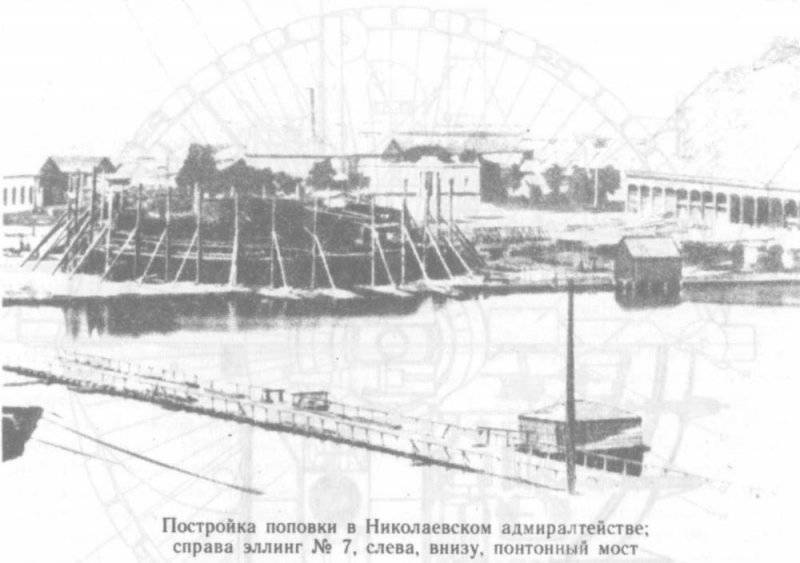
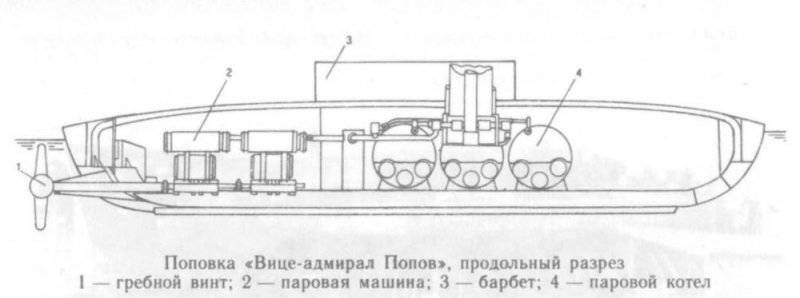
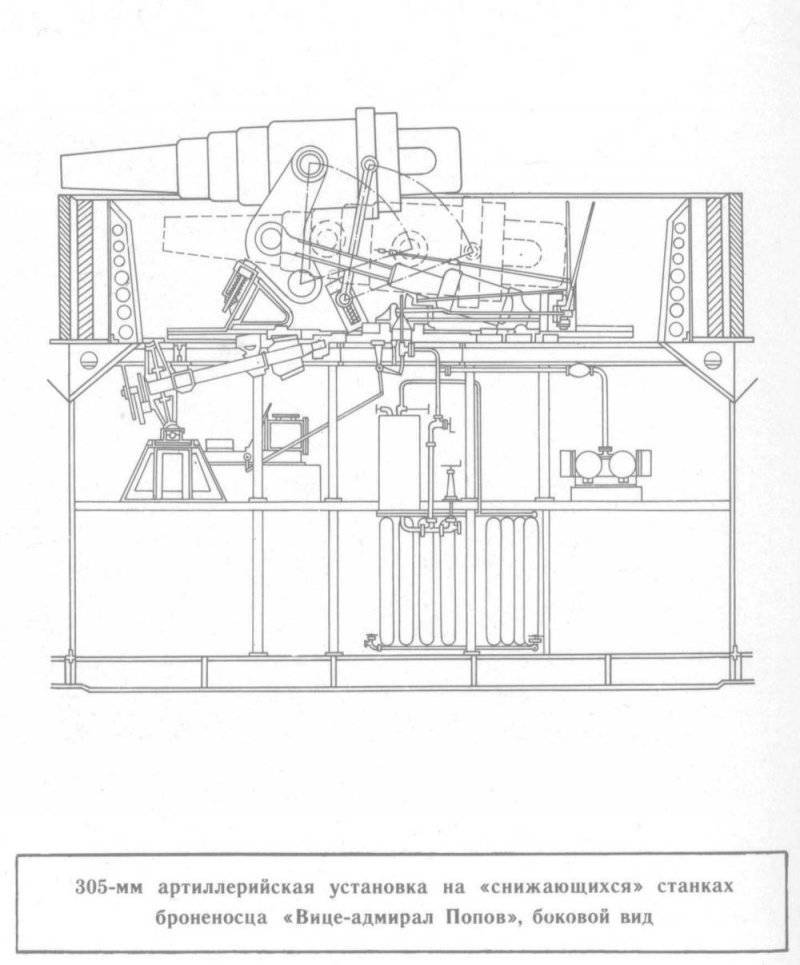
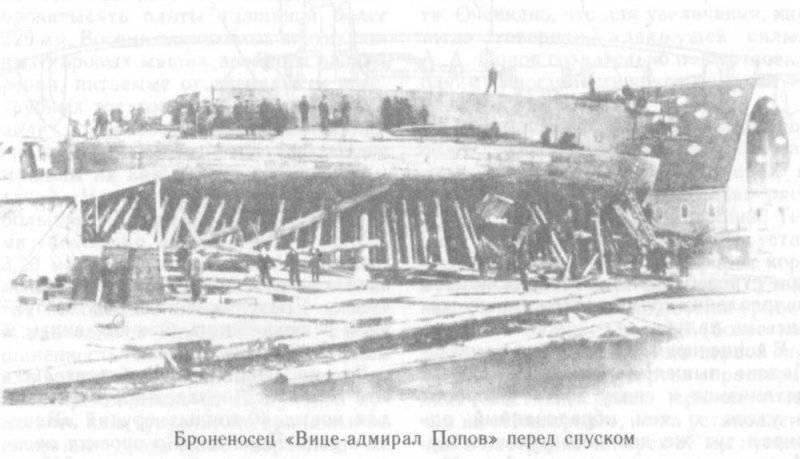
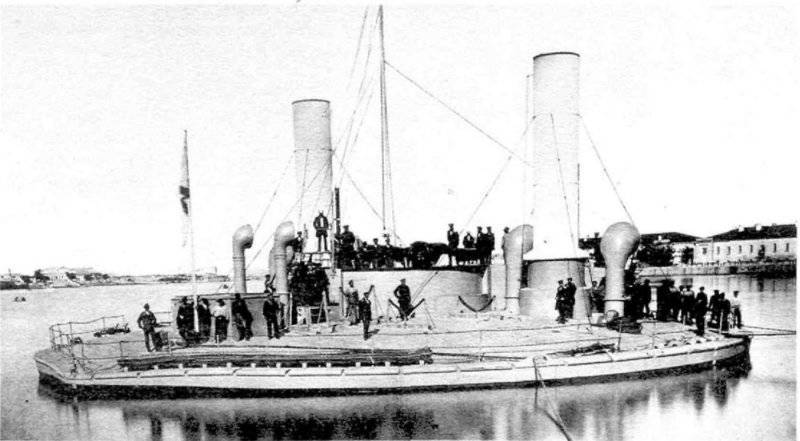
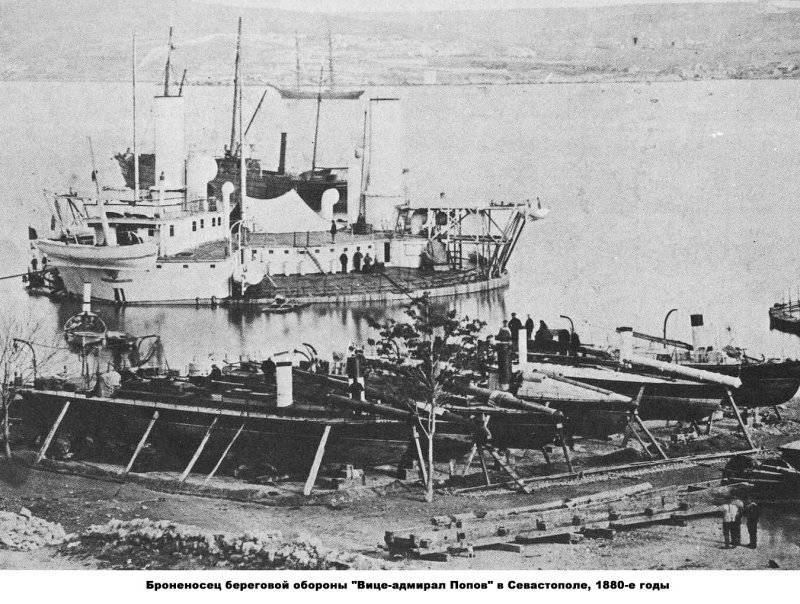
Information